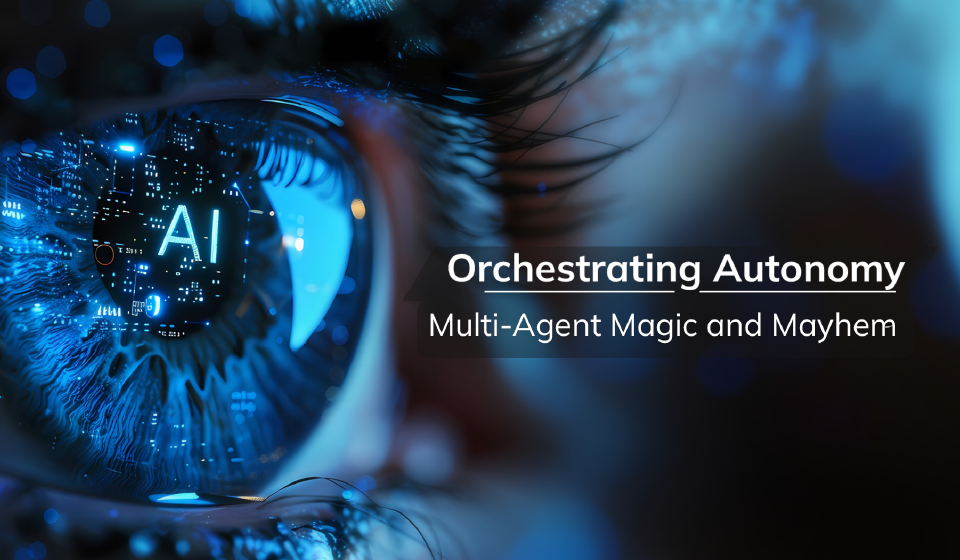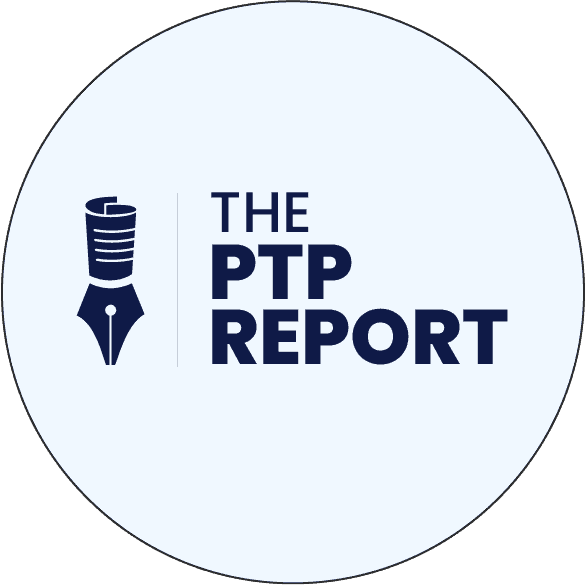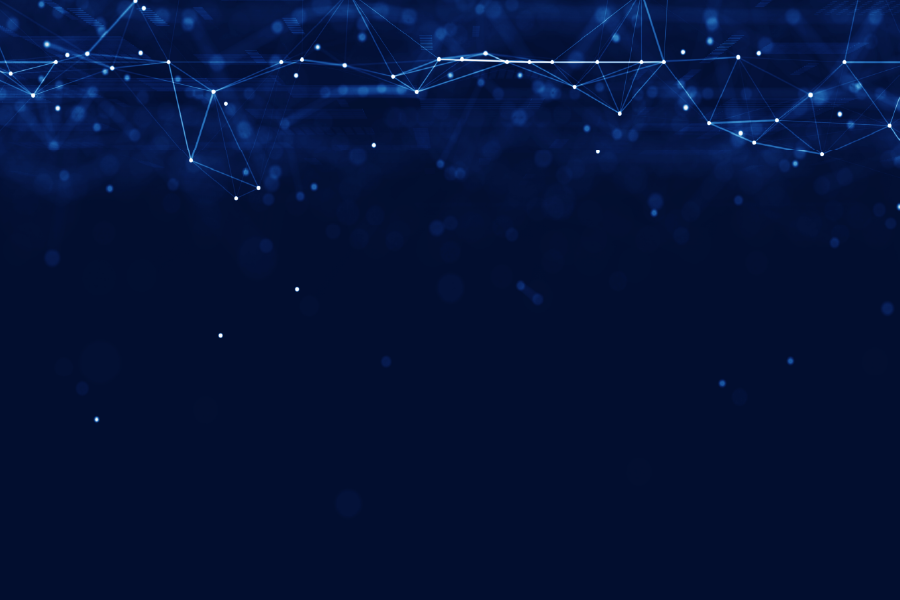“We’re going to operate in a multiagent world,” says Brad Anderson, president of product, user experience, and engineering at Qualtrics, speaking with Business Insider’s Rebecca Knight.
“Agents will interact both across and within organizations and integrate into existing research programs, brand trackers, and employee experience workflows.”
He gives several examples of autonomous AI agents in use:
- Flight Cancelation: From a survey, a customer unsure of a refund gets a personalized response in the airline’s tone, with eligibility and a timeline specific to the situation, taking into account loyalty status and lifetime value.
- Customer Form Frustration: Agentic systems can detect a customer’s frustration with credit card form entry (mouse thrashing, dead links, excessive clicks) and attempt to resolve. Failing that, the AI agent suggests alternative payment methods to salvage the sale while flagging the issue.
- Shopping Sporting Goods: Customer visiting site is given personal recommendations from prior sales. The agent can queue up options to best suit the customer, providing differences (pros and cons) and fielding customer inquiries across brands on the fly.
- Closing the Feedback Loop: Instead of drawing from just one source like surveys, agentic systems also can pull in reviews across dozens of websites and social media, at scale, and act from the insights without delay. (See below for more examples of this.)
And as companies work to implement AI solutions like these for their needs, many are realizing that giant, monolithic LLMs that can do everything are less practical (and affordable).
Computer-use agents, coding agents, reasoning AI, and LLMs all solve different kinds of problems in differing ways.
The multi-agent system (MAS) looks to capitalize on the best of all of them for need.
In today’s PTP Report, we examine this work in progress, considering current and emerging benefits of multi-agent frameworks and ways companies are organizing them for greater efficiency, reliability, and safety. We profile the risks and methods being used to combat them and consider a few examples of multi-agent systems coming online now.
If the present is AI agents, the future is AI agent collaboration.
Implementing Multi-Agent AI Systems
We all know no one’s great at everything.
Yet the biggest and most famous AI systems, trained across vast swaths of information, have largely followed this course. When you’ve looked at benchmark leaderboards (no matter the topic, from math to writing to designing Minecraft builds), you usually see the same few LLMs up near the top. The biggest, most expensive, and most resource-intensive systems do it all.
With many of the AI powers having a stated mission of reaching AGI, this makes sense. But for companies looking to automate routine tasks, improve consistency, scale at specific things, this kind of solution can often be overkill.
Smaller models fine-tuned for limited expertise are not only more affordable, but they’re also far more energy efficient (up to 90% per multiple studies), and yet they can still be combined in larger architectures to work across purposes.
This was arguably the biggest area of breakthrough for Chinese pioneer DeepSeek, whose Mixture-of-Experts (MoE) approach combined smaller, focused models and larger oversight models to work across them, at startling cost and energy savings.
This approach also more closely mirrors human teamwork, with various specialties, delegation, collaboration, management, assistance, and oversight spread amongst us.
In Cost-Effective AI, One Size Doesn’t Fit All
This same behavior, it turns out, suits agents, or AI systems empowered to take actions like web searching, internal document handling, code execution, or media generation.
Specific tasks are delegated to smaller agents (functioning like smart tools in many cases) which can then be tasked, monitored, and coordinated by other agents. Depending on the use case, they can also exchange information and even determine when to involve other agents.
In MAS, the smallest units are specialized and given permissions only for certain tasks, making the system modular and scalable. And while this can bring a good deal of added complexity into the mix (see below), and requires optimization to avoid straining performance, it also extends AI behavior and enables the automation of complex workflows.
Depending on need, such systems can enhance problem solving capacity over a single reasoning unit, reduce errors, enable greater adaptability, and also cut costs.
Wired’s Will Knight profiled the startup Simular in April, whose singular agent S2 switches among AI models based on need. It also learns as it goes, making use of an external memory module.
At this time, S2 is also faring very well on agentic benchmarks like OSWorld, where its best-of-breed approach is beating OpenAI’s Operator, for example. (S2’s use of Claude 3.7 is also beating Anthropic’s Claude 3.7 benchmark.)
And while these agent measures still have a way to go to catch up to human level (72% of OSWorld tasks, vs 42% from the best AI agent at the time of this writing), they’re gaining on us very fast.
Still, S2 functions more like a singular agent that strings together tasks than a MAS.
Working with AI Agent Frameworks
For agents to truly work together, there must be a means of orchestrating between them, which can ideally cross all manner of corporate and systematic divides.
Agent-to-agent protocols exist for this reason, such as Google’s A2A. It aims to enable communication and interoperability across black-box applications. By ensuring standards for discoverability, communication, and data exchange, standards like these enable layers of agents to work together, across ecosystems, and pave the way for interlocking systems.
They also aim to preserve AI agent data privacy, also obscuring specific usage and enhancing security.
Some frameworks that allow users to take advantage of this now include Microsoft’s AutoGen, LangChain, OpenAI Swarm (and Agents SDK), and ChatDev.
AI Agent Orchestration: Design Patterns in Action
While putting systems of AI agents in use together may be new for many organizations, the scholarship on MAS isn’t.
By default, a multi-agent system may be a user working through an interlocutor agent that then uses a series of sub-agents to execute tasks. And while this form of delegation can still improve efficiencies, more complex approaches can do far more.
Developers are using tools like AutoGen to put theoretical MAS design patterns to use, taking systems beyond simple multi-agent delegation, achieving practical AI management of other AI processes, reduced AI agent hallucination, and code quality improvements.
And while there are numerous approaches, here’s a look at some well-established examples:
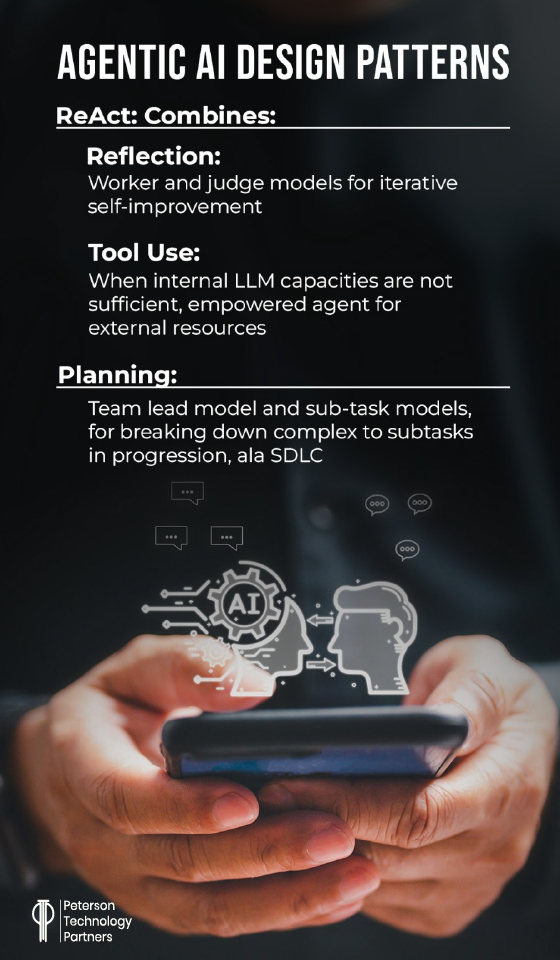
The reflection pattern is a way to leverage multiple agents to make an AI check itself, for more reliable outputs. By using one agent to generate potential outputs (your main LLM, gathering possibilities) checked by another (a judge or critic LLM), a MAS built in this pattern can loop until a necessary output quality is reached.
The tool use pattern is ideal for extending a single AI’s capacity, by giving it permissions and capacity to use external tools to get information or execute tasks beyond a system’s training data. (A simple form is using a web-browser, for example, but it can include SaaS systems, security, data management, and more.)
By combining these into a ReAct pattern (reasoning and acting), a MAS can leverage multiple tools to generate and evaluate outputs until they reach sufficient quality, such as for travel agency or even medical diagnosis.
And while such an approach adds a great deal of complexity and overhead and requires optimization to avoid lag, it also can bring together both greater complexity to sourcing and sophistication to evaluation.
Planning is a MAS approach for achieving strategic thinking, or to execute multi-step tasks with delegation among agents, such as in a software development life cycle (SDLC), for example. While it’s overkill for simpler asks, such a model can handle multi-step processes where each step may require its own iteration and refinement.
Of course there are startups in the MAS space as well. One example profiled by Venture Beat in May is Korl. It provides a platform to mix models from OpenAI, Google DeepMind, and Anthropic, as well as working across systems like Salesforce, Jira, Google Docs, and custom dashboards to generate and deliver customer-ready materials.
Calling their version an “ensemble of models,” like S2, Korl chooses systems based on need, considering speed, accuracy, and cost. It also works from a custom mapper to make use of third-party solutions, building and refining outputs as needed.
Risks in Multi-Agent AI Systems: Complexity, Emergence, and Governance
At a time when individual agents are still failing much of the time, there are clear issues that need to be ironed out before such systems can really shine.
In addition to all the usual care needed to safely govern single agents (monitoring data in and out for unsafe inputs and invalid outputs, and having people in the loop for alignment, tuning, and ideally red-teaming), MAS introduce some of their own concerns, including:
- Complexities and Cost: While the modularity of these systems scale well, and they bring added capacities at a much greater speed (thus improving function and decreasing operational costs), initial expenses will be much higher. Gartner estimates setup costs for MAS can more than double (and even quadruple), depending on the complexity.
- Impending AI Agent Security Risks: As covered in our last PTP Report, it turns out cyber criminals aren’t using the power of agents (nor hacking into them) all that much yet. But they will soon, and experts urge businesses to be ready before cybercrime has its own agentic “ChatGPT moment.” It’s not if but when.
- Game Theory and AI Agent Emergent Behavior: Carnegie Melon professor and OpenAI board member Zico Kolter, in an interview with Wired’s Will Knight, says he starts his AI security talks now with agents, as they can increasingly impact the world and prove far more problematic than chatbots. How do we extend game theory for agent collaboration? While we know what can come from human interaction: “We have much less understanding of what will emerge when different AI agents with different aims, different purposes, all start interacting.”
The threat here is about outputs that aren’t just the sum of their parts but rather can become something new and very difficult to anticipate.
To combat this, companies like Salesforce are utilizing agents themselves to monitor other agents (as “watchdogs”) and flag undesired behaviors, as well as establishing clear guidelines for allowable interactions and monitoring ongoing behavior.
MAS in Action: Combining AI Agent Applications at Work
Many companies are piloting enterprise AI automation in this vein, including:
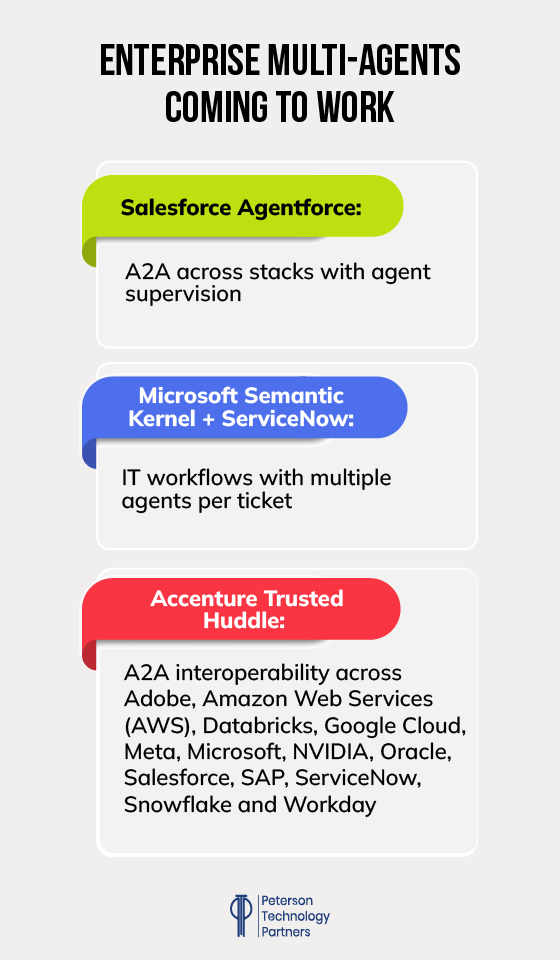
Salesforce has maintained a focus on developing a multi-agent framework with the goal of allowing enterprise agents to work with other agents, for example across systems (or with personal agents) to get things done. As with the A2A frameworks above, specialized agents from IT to retail to finance to CX can be called on by other agents to autonomously fulfill tasks and interact as needed.
ServiceNow has partnered with Microsoft on a multi-agent framework using a manager agent structure with subordinate sub-agents. Working from a list of actions to be executed and a knowledge of the capacities of all the agents it can call on, this MAS manages incident response activities, even for a Priority 1 event for a customer. The system can handle the gamut, from ticket parsing to escalation to interface with systems, to radically reduce the time required to deal with emergency situations.
Accenture introduced its Trusted Huddle MAS in late April, another A2A system working across partners like Adobe, Amazon Web Services (AWS), Databricks, Google Cloud, Meta, Microsoft, NVIDIA, Oracle, Salesforce, SAP, ServiceNow, Snowflake, and Workday to enable agents to all function together in a single platform, seamlessly. Like the Salesforce model, it also evaluates agent performance for optimization and security.
FedEx has been announced as a company piloting this system to improve their complex supply chain.
Humans, MAS, and the Role of Expertise
Agents, whether alone or in tandem, are far from infallible. But one research project puts numbers to the secret sauce for AI productivity in the near term.
CowPilot, a Chrome plugin developed at Carnegie Melon that allows a person to intervene when an AI agent bogs down, has seen impressive results in their initial testing. By pairing agentic technology with human assistance when needed, they’ve found a 95% success rate on assigned tasks, as reported by Wired.
And with humans only performing 15% of steps.
In other words, the work is better than either AI or people working alone and done in a fraction of the time.
And for human assistance, whether you’re experimenting with MAS architectures for your business, getting your data AI-ready, or implementing Salesforce or Adobe, PTP has the talent to help you get there.
With more than 27 years of experience providing top tech talent onshore, offshore, or nearshore, onsite or off, consider PTP for people you need to make AI work for you.
Conclusion
Gartner has predicted that a third of all GenAI interactions by 2028 will involve agents, but that may be short of the mark.
Multi-agent systems, which take advantage of the best of AI offerings, paired with systems of smaller scale and sharper focus, can bring workflow solutions capable of greater precision, adaptability, and efficiency than the monolithic LLM powerhouses working alone.
The best can pick and choose as the situation demands, leverage tuned expertise, work with tools across vendors, and avoid wasting precious resources.
And while they’re at their best collaborating like people do, on teams with dedicated expertise and skillful communication, they also work best alongside, and empowering, us.
References
Qualtrics’ president of product has a vision for agentic AI in the workplace: ‘We’re going to operate in a multiagent world’, Business Insider
Meet The AI Agent With Multiple Personalities and The AI Agent Era Requires a New Kind of Game Theory, Wired
How OpenAI’s Agents SDK is Changing Task Management : Multi-Agent Systems Guide, Geeky Gadgets
4 Agentic AI Design Patterns & Real-World Examples [2025], AIMultiple Research
AI Agentic Design Patterns with AutoGen, DeepLearning AI
ChatDev: Communicative Agents for Software Development, arXiv:2307.07924
Startup Korl unveils multimodal, multi-agent tool for custom communication across disparate systems, Venture Beat
3 Ways to Responsibly Manage Multi-Agent Systems, Salesforce’s The 360 Blog
Customer Case Study: Pushing the Boundaries of Multi-Agent AI Collaboration with ServiceNow and Microsoft Semantic Kernel, Microsoft Dev Blogs
FAQs
What is a multi-agent system and how is it different than a single agent one?
An AI agent is a system that can use AI to achieve a provided task with some autonomy. While this can include making decisions or even swapping source AI models at a higher level, it is still singular in behavior, working through steps.
A multi-agent system makes use of more than one agent (often specialized) to combine their capacities for greater benefit. Using specialized agents in combination can improve modularity, scaling, efficiency, cost, and even end quality.
Why are so many companies investing in multi-agent systems now?
Whether combining more specialized agents together or facilitating the collaboration of agents from different companies or departments, multi-agent solutions are seen as the future for their ability to improve reliability, cost, and reach for AI.
With so many companies working to perfect their own AI agents, it’s a next logical step to allow them to work with the agents of other companies to better serve their customers.
How are multi-agent systems more energy efficient than larger, singular AI models?
DeepSeek’s Mixture-of-Experts solution showed the world that there can be great energy savings in using smaller, specialized models working under larger, oversight ones.
Multi-agent systems are an extension of this idea, allowing easier tasks to be delegated to lighter models, trained on less data, and requiring less power for inference of that data. By picking and choosing when to use which model, they can avoid wasting the power of the largest systems for every step of a workflow or every task needed to get a job done.

